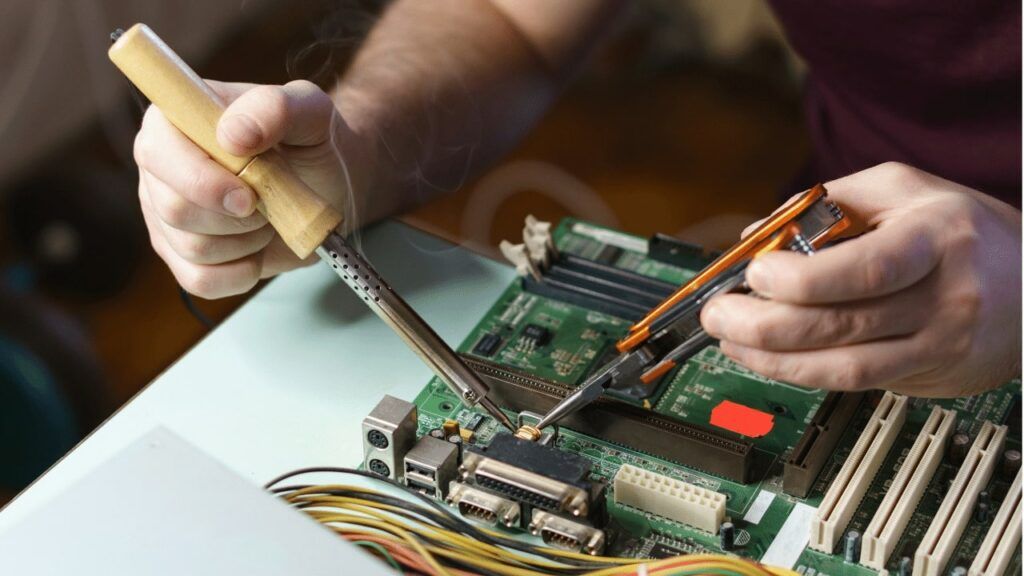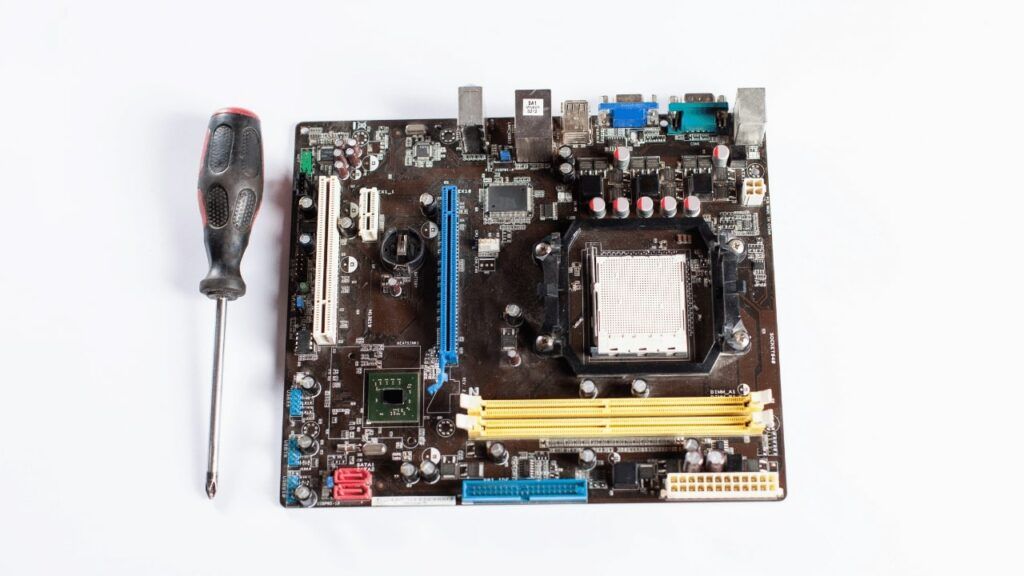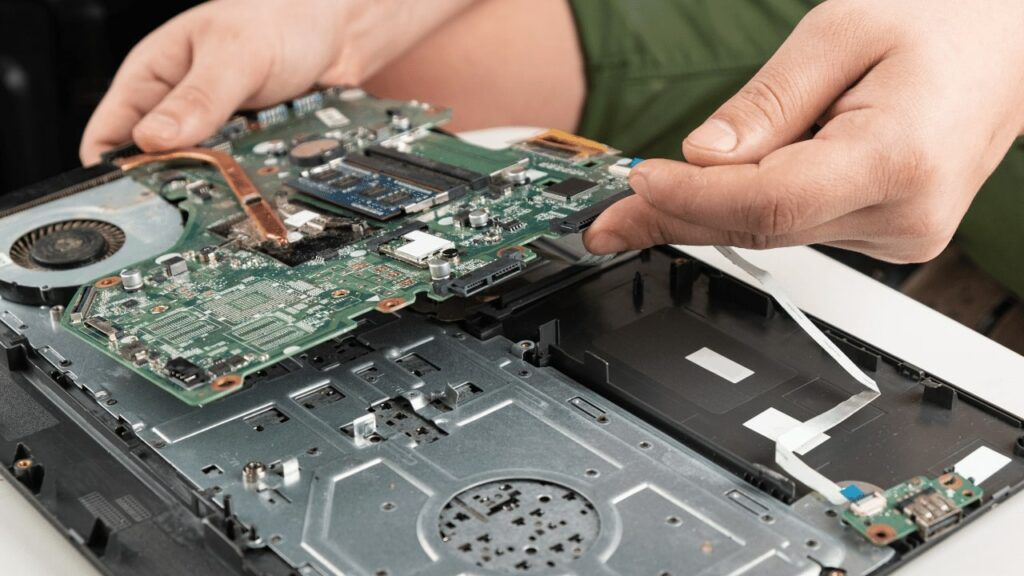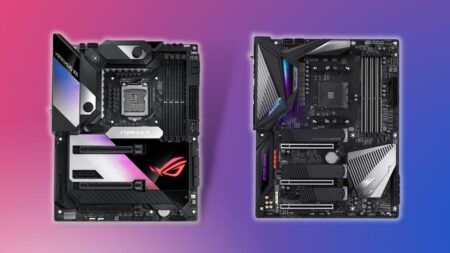A motherboard is the central printed circuit board (PCB) in many computers and holds together many of the crucial components of the system, including the central processing unit (CPU), memory, and connectors for input and output devices. But what happens when your motherboard starts to malfunction? Can it be repaired, or do you need to replace the entire thing?
In this article, we’ll explore everything you need to know about repairing a motherboard, from troubleshooting the problem to soldering on a new one. So if you’re wondering “can motherboard be repaired,” read on for all the answers.
Is Motherboard Worth Repairing?
Before we get into the process of repairing a motherboard, it’s important to ask yourself one question: is it worth repairing? In some cases, the answer will be a resounding yes. For example, if your motherboard is relatively new and under warranty, it may make more sense to simply send it back to the manufacturer for repairs.

On the other hand, if your motherboard is several years old or out of warranty, you may want to consider replacing it entirely. This is especially true if the cost of repairs would be close to the cost of buying a new motherboard.
So before you attempt any repairs on your own, be sure to weigh the costs and decide whether it’s worth your time and money.
Troubleshooting Your Motherboard
The first step in repairing your motherboard is to troubleshoot the problem. In many cases, you may be able to identify the issue without even opening up your computer case. Here are a few things to look for:

Is your computer turning on? If not, the problem could be with your power supply, which is providing electricity to the motherboard. Check that all cables are plugged in securely and that the power supply switch is turned on.
Are there any beep codes? Most computers will emit a series of beeps when they start up if there’s an error with the hardware. This can help you narrow down the problem to a specific component. Consult your motherboard manual to determine what the beep codes mean.
Are there any error messages on the screen? If you see an error message when you turn on your computer, it could be a sign that the motherboard is failing. Note down the exact message and search online for solutions.
Is your computer crashing or freezing? If your computer keeps crashing or freezing, this could be a sign of faulty memory modules (RAM). Try reseating the modules to see if this fixes the problem. If not, try testing the modules with a memory tester to see if they’re defective.
If you’re having trouble troubleshooting the problem yourself, you can always take your computer to a professional for help.
Also read: Best Motherboards for i9 10900K
Replacing Your Motherboard

In some cases, repairing your motherboard may not be possible or worth the cost. If this is the case, you’ll need to replace the motherboard entirely. This can be a daunting task, but don’t worry – we’ll walk you through the process step by step.
First, you’ll need to find a compatible replacement motherboard. To do this, you’ll need to know the model and make of your current motherboard, as well as the size (ATX, microATX, etc.). You can usually find this information in the manual or on the manufacturer’s website. Once you have this information, you can search for a compatible replacement online.
Once you’ve found a suitable replacement, it’s time to install it. First, shut down your computer and unplug all cables from the back. Then, remove the computer case so you can access the inside of the computer. Find the existing motherboard and disconnect all cables and components from it. Carefully remove the old motherboard and put the new one in its place.
Next, reconnect all cables and components to the new motherboard. Once everything is plugged in, replace the computer case and screw it into place. Finally, plug in all cables to the back of the computer and turn it on. If everything goes well, your computer should boot up as normal.
If you run into any issues during installation, don’t hesitate to ask for help from a professional or consult your motherboard manual.
Must read: Best Motherboards for Ryzen 9 3900X | Best Motherboards for RTX 3090 | Best Motherboards for Ryzen 3 3200G
Can Motherboard Destroy CPU?
It’s a common question asked by PC builders and one that doesn’t have a simple answer. The truth is, it depends on a number of factors.
Let’s start with the basics. A motherboard is responsible for connecting all the components of a computer together. The CPU (central processing unit) is the brain of the operation, and it sits in a socket on the motherboard.
The other important bits are RAM (random access memory), storage (usually in the form of an SSD or HDD), GPU (graphics processing unit), and peripherals like your keyboard, mouse, and monitor.
Now, onto the main question: can a motherboard damage a CPU? In short, yes, it is possible. If there is a sudden power surge or spike, it can cause damage to the motherboard and/or CPU. This is why it’s important to have a good quality power supply unit (PSU) that can regulate the flow of electricity.
Additionally, if you’re overclocking your CPU (running it at a higher speed than its default settings), this puts additional stress on the component and can lead to damage. Overheating is also a major concern, as it can permanently damage or shorten the lifespan of both the CPU and motherboard.
So, there you have it. While it is technically possible for a motherboard to damage a CPU, there are ways to avoid it. Make sure you have a good quality PSU that can handle any sudden power surges and don’t push your CPU to its limits by overclocking it. And last but not least, keep an eye on temperatures to avoid damaging your computer components.
You may also like: Best RAM for Fortnite
What Causes Motherboard To Fail?
There are many reasons why a motherboard might fail. Sometimes, it’s due to a manufacturing defect. Other times, it can be caused by physical damage, or by electrostatic discharge. Here are some of the most common causes of motherboard failure:
1. Manufacturing defects: Even the best quality control procedures can’t always prevent a defective motherboard from slipping through. If your motherboard is defective, you’ll likely need to get a replacement from the manufacturer.
2. Physical damage: If your motherboard sustains physical damage, it may no longer be able to function properly. For example, if the board is dropped or stepped on, it could crack or break one of its components. In severe cases, physical damage can render a motherboard completely unusable.
3. Electrostatic discharge: Electrostatic discharge (ESD) can damage sensitive electronic components, including motherboards. ESD can occur when you touch a charged object, such as a doorknob after walking across a carpeted floor. It can also happen if you accidentally touch the exposed metal contacts on a memory module or expansion card. To protect your motherboard from ESD, always ground yourself before handling it, and avoid touching any of its exposed metal contacts.
4. Power surges: A power surge is a sudden increase in voltage that can damage sensitive electronic components, including motherboards. Power surges can be caused by lightning strikes, power outages, or faulty electrical equipment. To protect your motherboard from power surges, always use a surge protector.
5. Overheating: If your computer case isn’t properly ventilated, or if you’re using too much high-powered hardware for the size of your case, your motherboard can overheat. This can cause permanent damage to the board, and may even lead to a fire. To prevent overheating, make sure your computer case is well-ventilated, and don’t overload it with too much hardware.
We suggest you use Liquid CPU Coolers to cool down your motherboard.
These are just some of the most common causes of motherboard failure. If you suspect that your motherboard is failing, take it to a qualified technician for diagnosis and repairs.
FAQs
Frequently Asked Questions
Can a bad motherboard cause crashing?
Yes, a bad motherboard can cause crashing. If the motherboard is defective, it may not be able to properly connect the components of your computer. This can lead to instability and crashes.
Can a bad motherboard cause blue screen of death?
Yes, a bad motherboard can cause blue screen of death. If the motherboard is defective, it may not be able to properly connect the components of your computer. This can lead to instability and blue screen of death errors.
Can bad RAM damage the motherboard?
Bad RAM can damage the motherboard. If the RAM is defective, it may send electrical spikes that can damage the motherboard. In severe cases, this can render the motherboard unusable.
What are the signs of a failing motherboard?
Some common signs of a failing motherboard include random reboot, blue screen of death errors, stability issues, and hardware failures. If you notice any of these issues, take your computer to a qualified technician for diagnosis and repairs.
How do I fix a bad motherboard?
If you suspect that your motherboard is bad, take it to a qualified technician for diagnosis and repairs. In most cases, the only way to fix a bad motherboard is to replace it.
Do you need to reinstall Windows after replacing the motherboard?
Yes, you will need to reinstall Windows after replacing the motherboard. This is because the drivers for the new motherboard will not be compatible with the existing installation of Windows.
Can I change the processor without changing the motherboard?
No, you cannot change the processor without changing the motherboard. The two components are not compatible with each other.
How do I know if my motherboard is fried?
If your motherboard is fried, it will no longer be able to power on or function properly. In most cases, a fried motherboard will need to be replaced.
Can a bad motherboard cause no display?
Yes, a bad motherboard can cause no display. If the motherboard is defective, it may not be able to properly connect the components of your computer. This can lead to instability and no display.
Will I lose my data if I change my motherboard?
If you don’t properly backup your data before changing the motherboard, you will lose your data. Make sure to backup your data to an external storage device before changing the motherboard.
Can I replace my motherboard with a different brand?
Yes, you can replace your motherboard with a different brand. However, you may need to reinstall Windows and all of your programs after doing so. Additionally, the new motherboard may not be compatible with your existing hardware. It’s always best to consult with a qualified technician before changing your motherboard.
How do I know if my motherboard is compatible with my CPU?
You can check the compatibility of your motherboard and CPU by looking up the specifications of both devices.
Conclusion
We hope this article has answered your question, “can motherboard be repaired?” In most cases, it is possible to repair a damaged or faulty motherboard. However, in some cases, it may be more cost-effective to replace the motherboard entirely.
If you’re still having trouble deciding what to do, we suggest taking your computer to a professional for help. They will be able to diagnose the problem and recommend the best course of action.
![Can Motherboards Be Repaired? [All You Need To Know]](https://ik.imagekit.io/pcfolk/wp-content/uploads/2022/05/Can-Motherboards-Be-Repaired-915x515.png)
